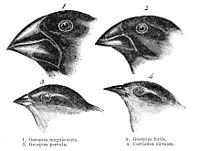
Photo from wikipedia
Long-term natural and artificial selection leads to change in certain regions of the genome, resulting in selection signatures that can reveal genes associated with selected traits, such as horns (i.e.,… Click to show full abstract
Long-term natural and artificial selection leads to change in certain regions of the genome, resulting in selection signatures that can reveal genes associated with selected traits, such as horns (i.e., polled/horned), high-quality wool traits, and high-altitude hypoxia adaptability. These are complex traits determined by multiple genes, regulatory pathways, and environmental factors. A list of genes with considerable effects on horn and adaptability traits has not been found, although multiple quantitative trait loci (QTL) have been identified. Selection signatures could be identified using genetic differentiation (FST), polymorphism levels θπ, and Tajima’s D. This study aimed to identify selection signatures in fine-wool sheep and to investigate the genes annotated in these regions, as well as the biological pathways involved in horn and adaptability traits. For this purpose, the whole-genome sequence of 120 individuals from four breeds, which come from different elevations and habitats in China, was used to analyze selection signatures for horn and adaptability traits. Annotation of the consensus regions of FST and θπ ratios revealed a list of identified genes associated with polled/horned and high-altitude hypoxia adaptability traits, such as RXPF2, EERFC4, MSH6, PP1R12A, THBS1, ATP1B2, RYR2, and PLA2G2E. Gene ontology (GO) and Kyoto Encyclopedia of Genes and Genomes (KEGG) analysis identified genes related primarily to mismatch repair, metabolism, vascular smooth muscle contraction, and cardiac muscle contraction. This is the first study to demonstrate that selection signatures play an important role in the polled/horned and high-altitude hypoxia adaptability traits of fine-wool sheep breeds that have undergone high-intensity selection and adapted to different ecological environments in China. Changes observed in the genome of fine-wool sheep may have acted on genomic regions that affect performance traits and provide a reference for genome design and breeding.
Journal Title: Frontiers in Genetics
Year Published: 2021
Link to full text (if available)
Share on Social Media: Sign Up to like & get
recommendations!